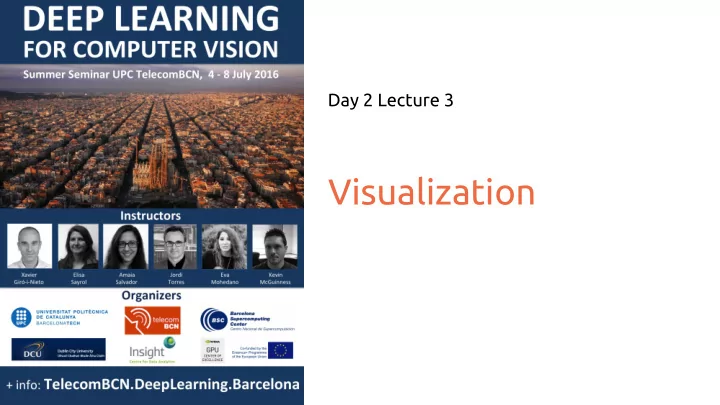

Day 2 Lecture 3 Visualization
Visualization Understand what ConvNets learn 2
Visualization The development of better convnets Visualization can help in is reduced to trial-and-error. proposing better architectures. 3
Visualization ● Learned weights ● Activations from data ● Representation space ● Deconvolution-based ● Optimization-based ● DeepDream ● Neural Style 4
Visualization ● Learned weights ● Activations from data ● Representation space ● Deconvolution-based ● Optimization-based ● DeepDream ● Neural Style 5
Visualize Learned Weights AlexNet conv1 Filters are only interpretable on the first layer 6
Visualize Learned Weights layer 2 weights layer 3 weights Source: ConvnetJS 7
Visualization ● Learned weights ● Activations from data ● Representation space ● Deconvolution-based ● Optimization-based ● DeepDream ● Neural Style 8
Visualize Activations Visualize image patches that maximally activate a neuron 9 Girshick et al. Rich feature hierarchies for accurate object detection and semantic segmentation. CVPR 2014
Visualize Activations Occlusion experiments 1. Iteratively forward the same image through the network, occluding a different region at a time. 2. Keep track of the probability of the correct class w. r.t. the position of the occluder Zeiler and Fergus. Visualizing and Understanding Convolutional Networks. ECCV 2015 10
Visualization ● Learned weights ● Activations from data ● Representation space ● Deconvolution-based ● Optimization-based ● DeepDream ● Neural Style 11
Visualize Representation Space: t-SNE Extract fc7 as the 4096-dimensional code for each image 12
Visualize Representation Space: t-SNE Embed high dimensional data points (i.e. feature codes) so that pairwise distances are conserved in local neighborhoods. Maaten & Hinton. Visualizing High-Dimensional Data using t-SNE. Journal of Machine Learning Research (2008). 13
Visualize Representation Space: t-SNE t-SNE on fc7 features from AlexNet. Source: http://cs.stanford. edu/people/karpathy/cnnembed/ t-SNE implementation on scikit-learn 14
Visualization ● Learned weights ● Activations from data ● Representation space ● Deconvolution-based ● Optimization-based ● DeepDream ● Neural Style 15
Deconvolution approach Visualize the part of an image that mostly activates a neuron Compute the gradient of any neuron w.r.t. the image 1. Forward image up to the desired layer (e.g. conv5) 2. Set all gradients to 0 3. Set gradient for the neuron we are interested in to 1 4. Backpropagate to get reconstructed image (gradient on the image) 16
Deconvolution approach 1. Forward image up to the desired layer (e.g. conv5) 2. Set all gradients to 0 3. Set gradient for the neuron we are interested in to 1 4. Backpropagate to get reconstructed image (gradient on the image) Regular backprop Guided backprop* Guided backprop: Only positive gradients are back-propagated. Generates cleaner results. 17 Springenberg, Dosovitskiy, et al. Striving for Simplicity: The All Convolutional Net. ICLR 2015
Deconvolution approach 18 Springenberg, Dosovitskiy, et al. Striving for Simplicity: The All Convolutional Net. ICLR 2015
Visualization ● Learned weights ● Activations from data ● Representation space ● Deconvolution-based ● Optimization-based ● DeepDream ● Neural Style 19
Optimization approach Obtain the image that maximizes a class score 1. Forward random image 2. Set the gradient of the scores vector to be [0,0,0…,1,...,0,0] 3. Backprop (w/ L2 regularization) 4. Update image 5. Repeat Simonyan et al. Deep Inside Convolutional Networks: Visualising Image Classification Models and Saliency Maps, 2014 20
Optimization approach Simonyan et al. Deep Inside Convolutional Networks: Visualising Image Classification Models and Saliency Maps, 2014 21
Optimization approach Simonyan et al. Deep Inside Convolutional Networks: Visualising Image Classification Models and Saliency Maps, 2014 22
Deep Visualization Toolbox http://yosinski.com/deepvis 23 Optimization & Deconv-based visualizations
Visualization ● Learned weights ● Activations from data ● Representation space ● Deconvolution-based ● Optimization-based ● DeepDream ● Neural Style 24
DeepDream https://github.com/google/deepdream 25
DeepDream 1. Forward image up to some layer (e.g. conv5) 2. Set the gradients to equal the activations on that layer 3. Backprop (with regularization) 4. Update the image 5. Repeat 26
DeepDream 1. Forward image up to some layer (e.g. conv5) 2. Set the gradients to equal the activations on that layer 3. Backprop (with regularization) 4. Update the image 5. Repeat At each iteration, the image is updated to boost all features that activated in that layer in the forward pass. 27
DeepDream More examples here 28
Visualization ● Learned weights ● Activations from data ● Representation space ● Deconvolution-based ● Optimization-based ● DeepDream ● Neural Style 29
Neural Style Style image Content image Result Gatys et al. A neural algorithm of artistic style. 2015 30
Neural Style Extract raw activations in all layers. These activations will represent the contents of the image. Gatys et al. A neural algorithm of artistic style. 2015 31
Neural Style ● Activations are also extracted from the style image for all layers. ● Instead of the raw activations, gram matrices (G) are computed at each layer to represent the style. E.g. at conv5 [13x13x256], reshape to: 169 The Gram matrix G gives the correlations between filter responses. G = V T V V = 256 ... 32
Neural Style match content match style Match activations Match gram matrices from content image from style image Gatys et al. A neural algorithm of artistic style. 2015 33
Neural Style match content match style Match activations Match gram matrices from content image from style image Gatys et al. A neural algorithm of artistic style. 2015 34
Neural Style Gatys et al. A neural algorithm of artistic style. 2015 35
Visualization ● Learned weights ● Activations from data ● Representation space ● Deconvolution-based ● Optimization-based ● DeepDream ● Neural Style 36
Resources ● Related Lecture from CS231n @ Stanford [slides][video] ● ConvnetJS ● t-SNE visualization of CNN codes ● t-SNE implementation on scikit-learn ● Deepvis toolbox ● DrawNet from MIT: Visualize strong activations & connections between units ● 3D Visualization of a Convolutional Neural Network ● NeuralStyle: ○ Torch implementation ○ Deepart.io: Upload image, choose style, (wait), download new image with style :) ● Keras examples: ○ Optimization-based visualization Example in Keras ○ DeepDream in Keras ○ NeuralStyle in Keras 37
Recommend
More recommend